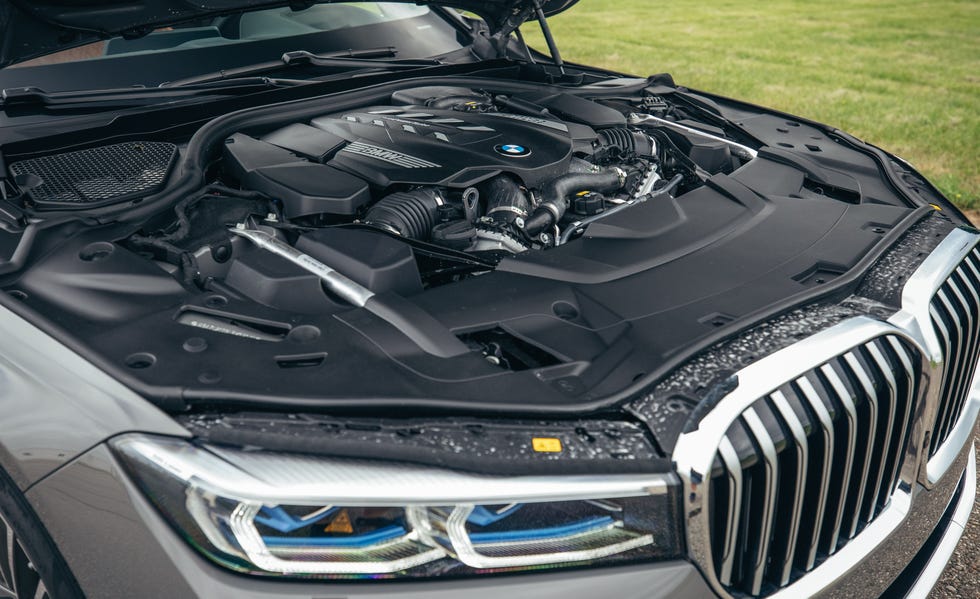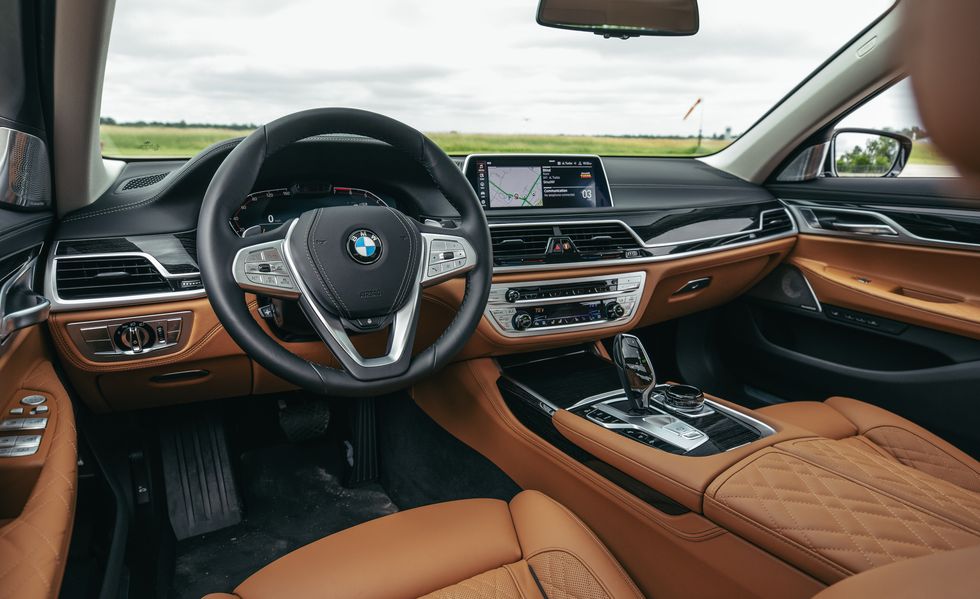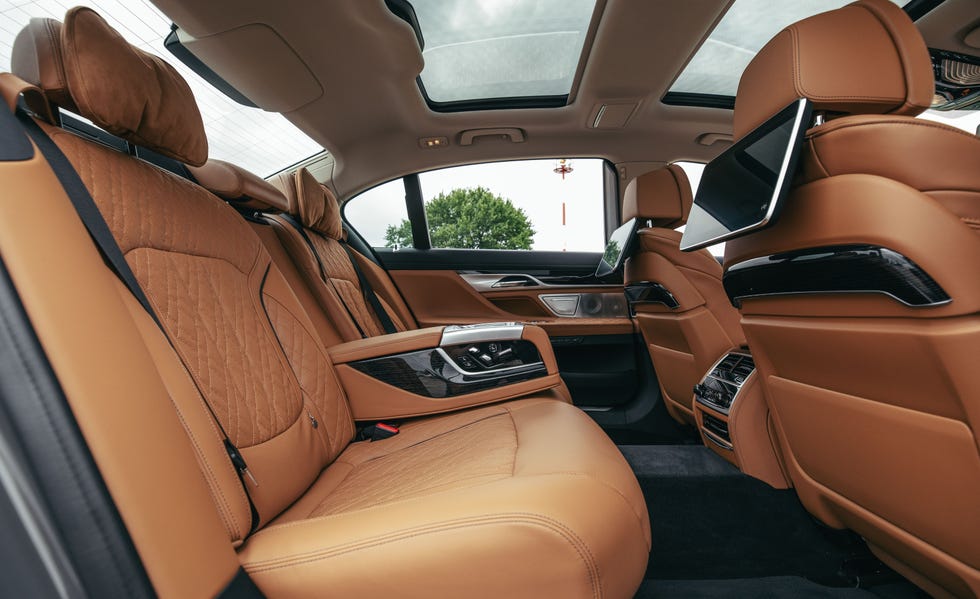Tested: 2020 BMW 7-Series Has Serious Power Behind Its Gaping Grille
This review has been updated with test results for the 750i xDrive model.
It’s more than a little obnoxious, that new grille on the BMW 7-series. The last car we can think of to have such a big grille that it couldn’t fit on the front of the car and needed to cut back into the hood was the 1977 Oldsmobile Cutlass—and everybody recognizes that ’70s Oldsmobiles were paragons of taste.
Then again, a larger grille naturally can ingest more air—think of the difference between sipping a soft drink through a straw and pouring beer down your gullet from an Oktoberfest stein. The official explanation for the updates to the V-8-powered 750i xDrive is a re-engineering from the crankcase up, but the grille at least hints at the increased power in the 2020 car. (With the exception of the base six-cylinder 740i version, all 7s are now all-wheel drive.) It’s not the 40 percent step up that the scale of that grille represents, but, at 523 horsepower and 553 lb-ft of torque, the new eight outpunches its predecessor by 80 horses and 74 lb-ft.

Michael Simari
|
Car and Driver
HIGHS: Good lord, it’s quick; sanctuary silent; rides like a Rolls-Royce.
Not that the car needed it. With all four Pirelli P Zeros—245/45R-20s up front and 275/35R-20s in back—digging in at launch, our 750i xDrive test car hit 60 mph in 4.0 seconds flat and tripped the timing lights in the quarter-mile in 12.5 seconds at 113 mph. Remember, this isn’t a sports car. It’s two-and-one-half tons of luxury sedan (4878 pounds to be exact). But it does a damn good impression of a sports car in a straight line. Peak torque lasts from 1800 to 4600 rpm, and with ZF’s excellent eight-speed automatic transmission backing it, the engine is never caught flat-footed. BMW’s boosted V-8 also can be relatively efficient: Despite averaging 18 mpg with us (2 mpg less than its EPA combined estimate), our example posted 29 mpg on our 75-mph highway fuel-economy test, a solid 4 mpg better than its official highway rating.
Plug It In, Plug It In
This first encounter with the facelifted 7er also provided us a brief opportunity to drive the new 745e plug-in hybrid. The fire-powered half of the propulsion equation gets upgraded from last year’s four-cylinder to BMW’s silky turbocharged 3.0-liter straight-six. The smoothest gas burner we’re aware of, the BMW inline-six does the best impression of an electric motor of any internal-combustion engine on the market today, making it a natural pairing with an actual electric motor. There’s a bit of a sound shift between electric and internal-combustion power, but almost no additional vibration enters the cabin when the six fires up.

Michael Simari
|
Car and Driver
A 12.0-kWh battery pack will provide approximately 35 miles of EV range, although engineers tell us the actual figure is higher than they are legally allowed to claim. Regulations in some countries require automakers to claim only as many miles as they can guarantee the battery pack will still provide after 10 years, so there’s some leeway built into that figure to accommodate the inevitable battery degradation. But in terms of the other kind of performance, the six-based hybrid system sees increases of 67 horsepower and 73 lb-ft, for totals of 389 and 442, respectively. Sounds like progress to us.
Whereby Wend the Winds (or Whatever)
In a BMW lineup that often seems at odds with the BMW we know and love (knew and loved?), the 7-series remains a polarizing car. On one hand, it does the best impression of a Rolls-Royce of any car outside of Rolls’s own showroom. On the other, though, in no suspension setting does it quite feel like that blue-and-white roundel belongs on the hood. Even with standard adaptive dampers and air springs at all four corners, none of the chassis settings quite feel right. Then again (so, back to that first hand?), the 750i xDrive did manage 0.88 g of lateral grip on the skidpad, and if a 7-series buyer really wants to drive something that handles like an M3, they probably just drive the M3 that day instead. Or whatever else is in the garage alongside the six-figure sedan.
LOWS: As if it weren’t easy enough for people to make assumptions about you because you’re driving a giant BMW, now the car itself is self-consciously broadcasting your importance.

Michael Simari
|
Car and Driver
If they do pluck the 7’s fob from whatever it is that people who have loads of cars keep their embarrassment of keys in—we assume it’s not the same haphazard pile in the junk drawer that we employ—the BMW is a coddling cocoon. There’s massive room front and rear, and the Rear Executive Lounge Seating package is so first class that a tray table even folds out of the center console. Drinks, it should be noted, are not complimentary. The big tech updates that accompany this facelift are voice controls for the infotainment system—by default it responds to “Hey BMW,” but can be customized to whatever name the owner sees fit—and the industry’s latest definitely-not-an-automated-driving-system. The latter is called Extended Traffic Jam Assistant, and it will drive the car indefinitely on divided highways at speeds below 37 mph as long as the camera in the instrument panel can see that the driver’s eyes are on the road. And BMW’s nonsensical gesture-control system now responds to more commands, but it still won’t let you program your own gestures. Soon, child. Soon.
And when can you get your shaky/greasy/silk-gloved hands on a 2020 7-series? Soon. Or now-ish. The 750i xDrive starts at $103,645, while the hybrid starts at $96,545. The lowly 740i is $87,445, and the range-topping V-12–powered M760i costs $158,695.

Michael Simari
|
Car and Driver
Arrow pointing downArrow pointing down
Specifications
Specifications
2020 BMW 750i xDrive
VEHICLE TYPE
front-engine, all-wheel-drive, 5-passenger, 4-door sedan
PRICE AS TESTED
$125,645 (base price: $103,645)
ENGINE TYPE
twin-turbocharged and intercooled DOHC 32-valve V-8, aluminum block and heads, direct fuel injection
Displacement
268 in3, 4,395 cm3
Power
523 hp @ 6,000 rpm
Torque
553 lb-ft @ 1,800 rpm
TRANSMISSION
8-speed automatic with manual shifting mode
CHASSIS
Suspension (F/R): multilink/multilink
Brakes (F/R): 14.7-in vented disc/14.6-in vented disc
Tires: Pirelli P Zero PZ4 Runflat, F: 245/40R-20 99Y ★ R: 275/35R-20 102Y ★
DIMENSIONS
Wheelbase: 126.4 in
Length: 207.4 in
Width: 74.9 in
Height: 58.2 in
Passenger volume: 115 ft3
Trunk volume: 18 ft3
Curb weight: 4878 lb
C/D
TEST RESULTS
Zero to 60 mph: 4.0 sec
Zero to 100 mph: 9.6 sec
Zero to 120 mph: 14.0 sec
Rolling start, 5–60 mph: 5.2 sec
Top gear, 30–50 mph: 2.7 sec
Top gear, 50–70 mph: 3.2 sec
Standing ¼-mile: 12.5 sec @ 113 mph
Top speed (governor limited): 128 mph
Braking, 70–0 mph: 170 ft
Roadholding, 300-ft-dia skidpad: 0.88 g
C/D
FUEL ECONOMY
Observed: 18 mpg
75-mph highway driving: 29 mpg
Highway range: 590 miles
EPA FUEL ECONOMY
Combined/city/highway: 20/17/25 mpg
c/d testing explained

Jared Gall
Deputy Editor, Features
Jared Gall started his career with Car and Driver as an unpaid intern, but has now worked here more than half of his life. He has held numerous positions within C/D’s digital and print teams and has driven some 2500 cars. Employee records indicate that he is the only staffer ever to T-bone a school bus with another school bus.






